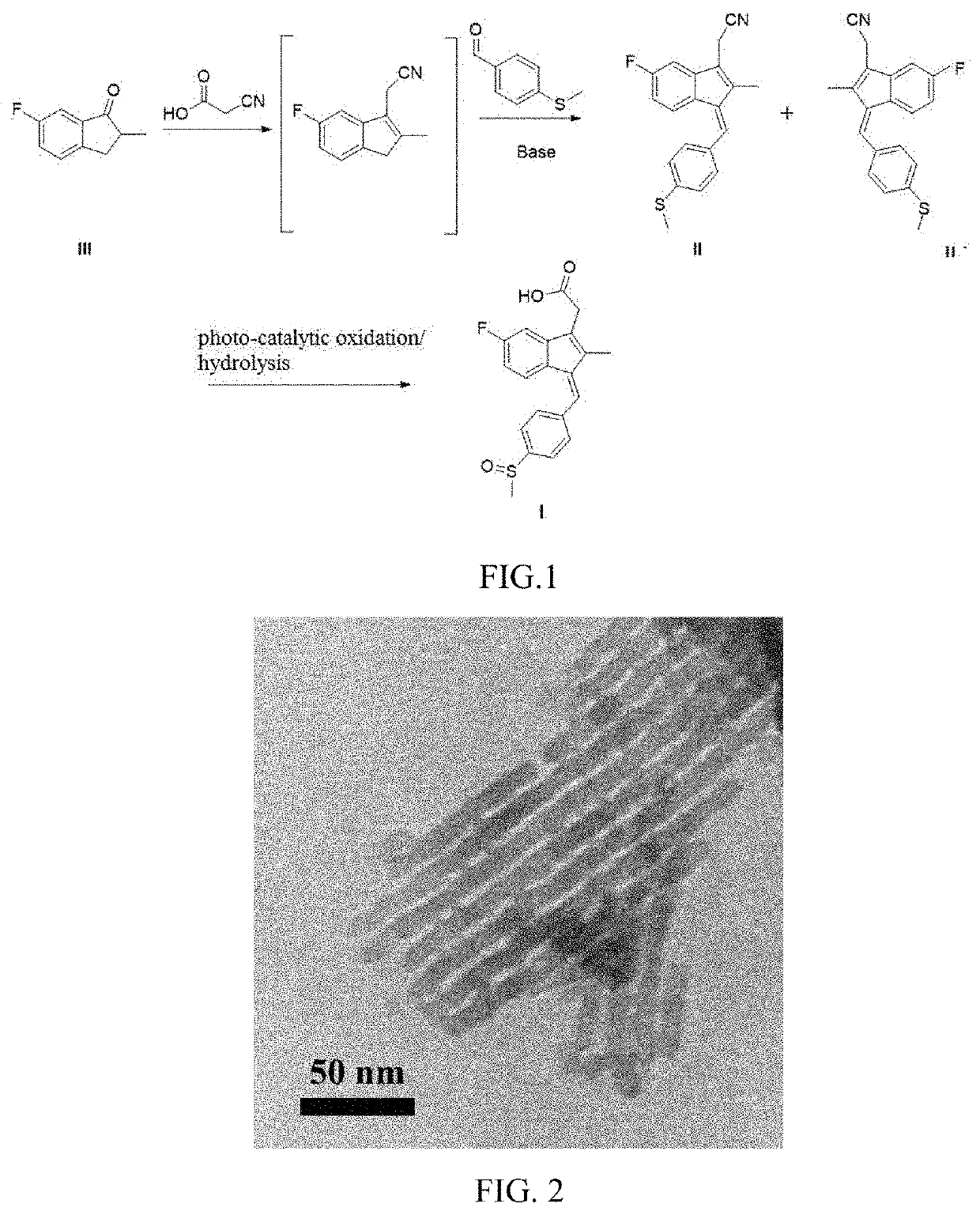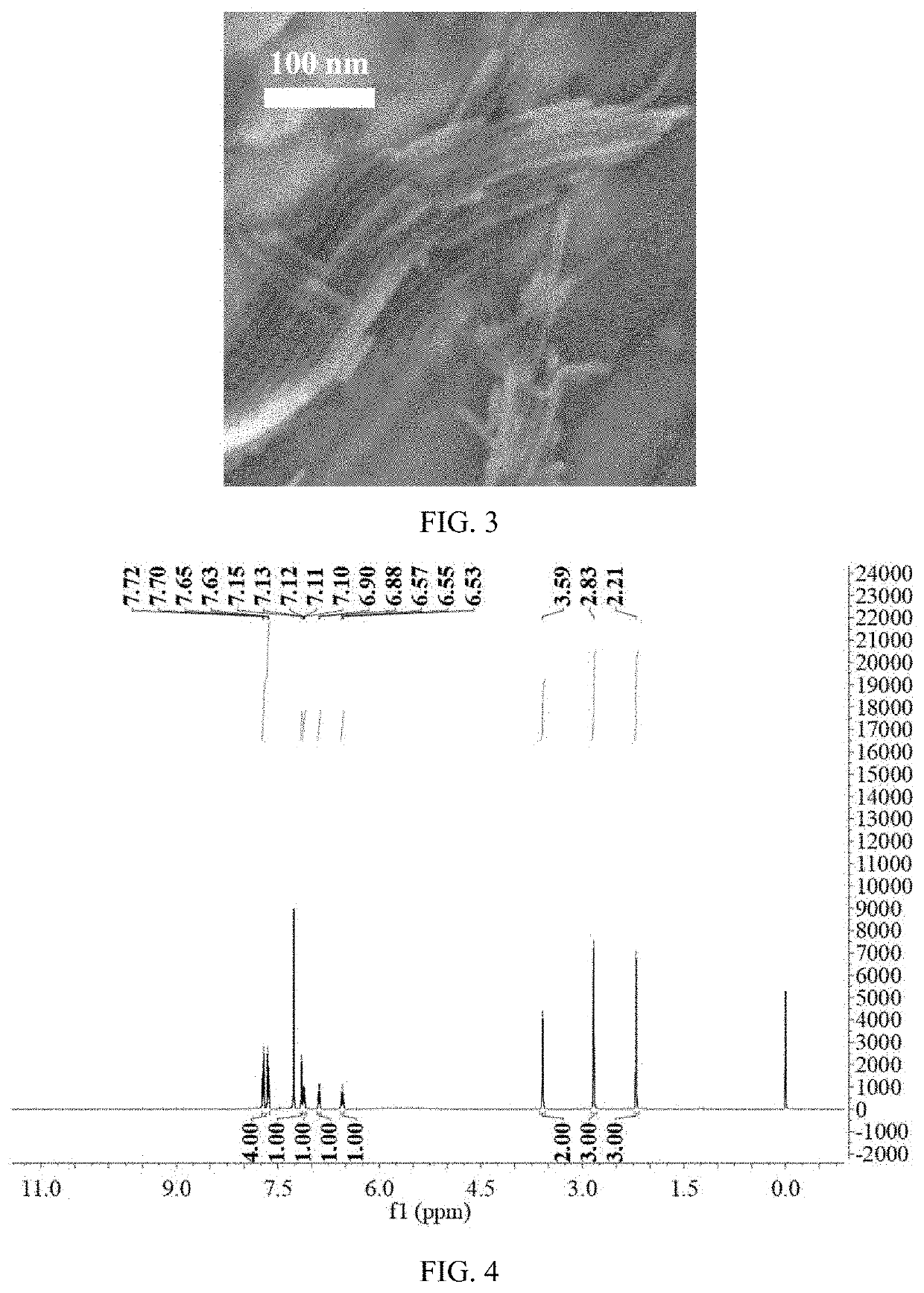Processes for preparing 5-fluoro-2-methyl-1-(4-methylthiobenzylidene)-3-indanacetonitrile and for preparing sulindac
- Summary
- Abstract
- Description
- Claims
- Application Information
AI Technical Summary
Benefits of technology
Problems solved by technology
Method used
Image
Examples
example 1
[0048]164 g of 6-fluoro-2-methylindanone, 100 g of cyanoacetic acid, 8.2 g of sodium acetate, and 328 g of xylene were introduced into a reaction vessel fitted with a thermometer, a stirrer, and a water separator. During the reaction, the reaction temperature was controlled at 50° C., and the reaction was carried out with removing water produced by the reaction by fractional distillation from the reaction system. After 5 hours of reaction, the reaction solution was cooled to 50° C., and 36 g of sodium hydride and 164 g of 4-(methylthio)benzaldehyde were then added into the reaction solution. The reaction solution was kept at 90° C. for 3 hours, then adjusted to neutral with 0.1 M hydrochloric acid and subjected to layer separation. An organic layer formed was evaporated at 135° C. for 1 h to dryness. A crude product obtained was recrystallized in 500 g of ethyl acetate at 78° C. for 4 h to obtain 283.8 g of 5-fluoro-2-methyl-1-(4-methylthiobenzylidene)-3-indanacetonitrile with a yie...
example 2
[0053]164 g of 6-fluoro-2-methylindanone, 170 g of cyanoacetic acid, 8.2 g of sodium acetate, 12 g of acetic acid, and 2460 g of toluene were introduced into a reaction vessel fitted with a thermometer, a stirrer, and a water separator. During the reaction, the reaction temperature was controlled at 100° C., and the reaction was carried out with removing water produced by the reaction by fractional distillation from the reaction system. After 30 hours of reaction, the reaction solution was cooled to 50° C., and 72 g of sodium hydride and 304 g of 4-(methylthio)benzaldehyde were then added into the reaction solution. The reaction solution was kept at 50° C. for 8 hours, then adjusted to neutral with 0.1 M hydrochloric acid and subjected to layer separation. An organic layer formed was evaporated at 110° C. for 1 h to dryness. A crude product obtained was recrystallized in 500 g of ethyl acetate at 78° C. for 4 h to obtain 264.5 g of 5-fluoro-2-methyl-1-(4-methylthiobenzylidene)-3-ind...
example 3
[0055]164 g of 6-fluoro-2-methylindanone, 85 g of cyanoacetic acid, 6 g of acetic acid, and 820 g of xylene were introduced into a reaction vessel fitted with a thermometer, a stirrer, and a water separator. During the reaction, the reaction temperature was controlled at 130° C., and the reaction was carried out with removing water produced by the reaction by fractional distillation from the reaction system. After 20 hours of reaction, the reaction solution was cooled to 50° C., and 24 g of sodium hydride and 152 g of 4-(methylthio)benzaldehyde were then added into the reaction solution. The reaction solution was kept at 50° C. for 8 hours, then adjusted to neutral with 0.1 M hydrochloric acid and subjected to layer separation. An organic layer formed was evaporated at 135° C. for 1 h to dryness. A crude product obtained was recrystallized in 500 g of ethyl acetate at 78° C. for 4 h to obtain 266.6 g of 5-fluoro-2-methyl-1-(4-methylthiobenzylidene)-3-indanacetonitrile with a yield o...
PUM
| Property | Measurement | Unit |
|---|---|---|
| Temperature | aaaaa | aaaaa |
| Temperature | aaaaa | aaaaa |
| Temperature | aaaaa | aaaaa |
Abstract
Description
Claims
Application Information
 Login to View More
Login to View More - R&D
- Intellectual Property
- Life Sciences
- Materials
- Tech Scout
- Unparalleled Data Quality
- Higher Quality Content
- 60% Fewer Hallucinations
Browse by: Latest US Patents, China's latest patents, Technical Efficacy Thesaurus, Application Domain, Technology Topic, Popular Technical Reports.
© 2025 PatSnap. All rights reserved.Legal|Privacy policy|Modern Slavery Act Transparency Statement|Sitemap|About US| Contact US: help@patsnap.com


